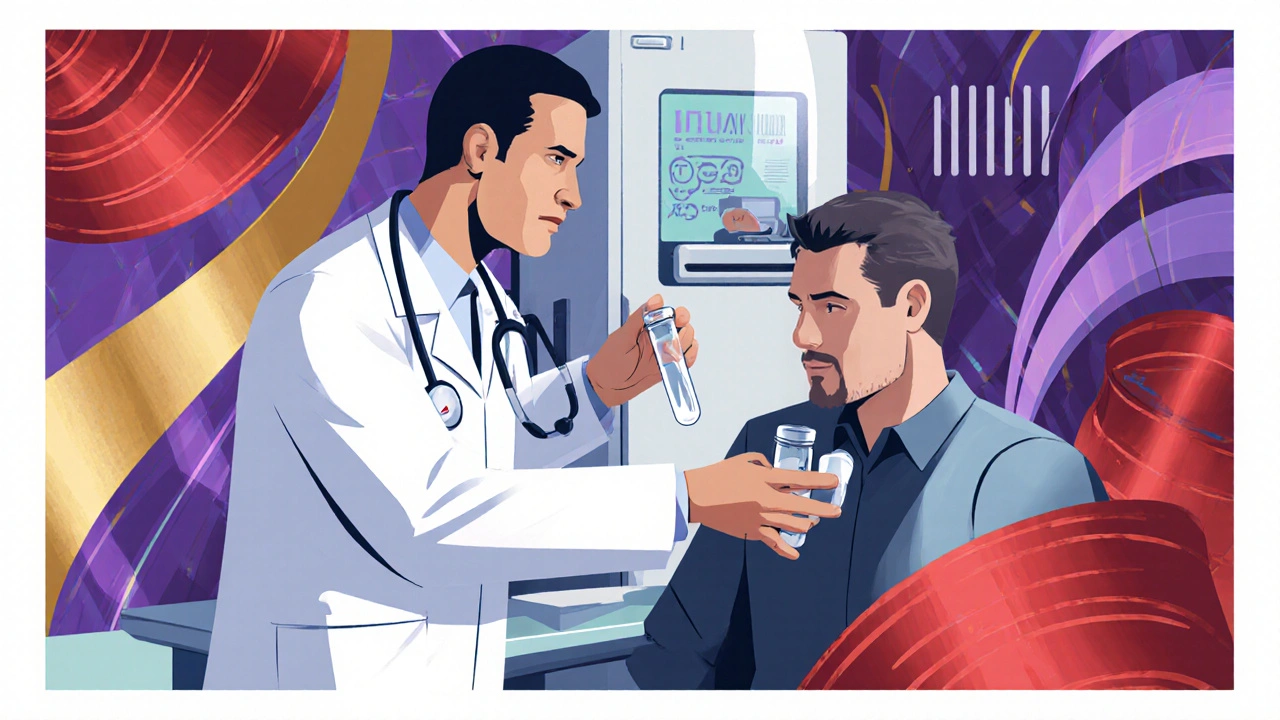Trichomoniasis Treatment Comparison Tool
Treatment Comparison Tool
Compare metronidazole and tinidazole for trichomoniasis treatment based on your individual preferences and circumstances.
If you suspect you have trichomoniasis, you’re not alone-many men experience subtle signs that can slip under the radar. This guide breaks down exactly what to watch for, how doctors confirm the infection, and which medicines work best. By the end you’ll know when to act, how to protect your partner, and what follow‑up steps keep the infection from coming back.
Key Takeaways
- Trichomoniasis in men often shows up as urethral discharge, irritation, or mild itching.
- A simple urine or urethral swab sent for PCR testing can confirm the parasite.
- First‑line treatment is a single dose of metronidazole; tinidazole is an effective alternative.
- Both partners must complete treatment to avoid re‑infection.
- Consistent condom use and regular STI screening are the best prevention tools.
What Is Trichomoniasis?
Trichomoniasis is a common sexually transmitted infection caused by the protozoan parasite Trichomonas vaginalis. The parasite thrives in warm, moist environments and spreads through vaginal, oral, or anal sex. While it’s often discussed in the context of women’s health, men can carry and transmit the infection just as easily.
How Trichomoniasis Affects Men
Men rarely experience the dramatic symptoms that women do, which is why the infection can linger unnoticed. The most frequent complaints include:
- Urethral discharge: a thin, frothy fluid that may be clear, yellow, or green.
- Irritation or burning: a sensation similar to a mild urinary tract infection, especially during or after urination.
- Itching or redness: usually around the penis head (glans) or the inner foreskin.
- Frequent urge to pee: a feeling of incomplete emptying that can be mistaken for prostatitis.
Because these signs are subtle, many men attribute them to harmless irritation or a yeast infection and never seek testing. Left untreated, the parasite can cause chronic urethritis and increase the risk of HIV transmission.

Why Symptoms Differ From Women
Women often notice a strong, unpleasant odor and a cottage‑cheese‑like vaginal discharge. Men, on the other hand, lack the large mucosal surface that magnifies these signs. The male urethra provides a smaller habitat, so the parasite’s growth is limited, resulting in milder, sometimes intermittent symptoms. This discrepancy makes public awareness campaigns that focus solely on women insufficient for curbing overall spread.
Getting a Diagnosis
The gold‑standard test is a nucleic acid amplification test (NAAT), commonly referred to as a PCR test. A clinician can collect a urine sample or a urethral swab and send it to a laboratory. The test looks for DNA fragments of Trichomonas vaginalis, delivering results in 1‑2 days.
Older methods-wet mount microscopy or culture-are still used in some low‑resource settings but are far less sensitive. If you have symptoms but a negative wet mount, ask your doctor for a PCR test to rule out false negatives.
Treatment Options
Both the Centers for Disease Control and Prevention (CDC) and the World Health Organization (WHO) list two oral antibiotics as first‑line therapy. The choice often hinges on side‑effect profiles, cost, and patient preference.
| Attribute | Metronidazole | Tinidazole |
|---|---|---|
| Dose | 2 g single dose OR 500 mg twice daily for 7 days | 2 g single dose |
| Effectiveness | ≈ 95 % cure rate | ≈ 96‑98 % cure rate |
| Common side‑effects | Nausea, metallic taste, mild headache | Less nausea, occasional dizziness |
| Alcohol interaction | Strict avoidance 24 h before/after | Strict avoidance 24 h before/after |
| Cost (US, 2025) | $15‑$25 | $30‑$45 |
Metronidazole is widely available and inexpensive, making it the go‑to drug for most clinics. Tinidazole, though pricier, offers a single‑dose regimen that many patients prefer for convenience.
Both drugs are contraindicated in the first trimester of pregnancy and should be used with caution in patients with liver disease. Always complete the full prescription, even if symptoms subside within a day.

Preventing Re‑infection
Because trichomoniasis is a sexually transmitted infection, treating only the diagnosed partner is not enough. Your sexual partner(s) must also take the full course of medication at the same time to break the transmission loop.
- Condom use: Consistent latex or polyurethane condoms reduce transmission by about 85 %.
- Partner notification: Inform your recent partners so they can get tested and treated.
- Regular STI screening: Annual testing for sexually active men, especially those with multiple partners, catches infections early.
Alcohol can worsen the side‑effects of the antibiotics, so avoid drinking for at least 24 hours before and after treatment.
When to Seek Medical Help
If you notice any of the symptoms listed above, especially a persistent urethral discharge or burning during urination, book an appointment within a week. Seek urgent care if you develop fever, severe pelvic pain, or blood in the urine-these could signal a secondary infection or prostatitis.
After completing treatment, a follow‑up test is recommended 3 weeks later to confirm eradication, especially if symptoms linger.
Frequently Asked Questions
Can men transmit trichomoniasis without showing symptoms?
Yes. Asymptomatic men can still carry the parasite and pass it to partners during sexual contact. That’s why routine STI testing is crucial even when you feel fine.
Is trichomoniasis the same as a yeast infection?
No. Trichomoniasis is caused by a protozoan parasite, while a yeast infection is a fungal overgrowth (Candida). Their treatments differ completely.
Can I take metronidazole if I drink alcohol?
It’s best to avoid alcohol for at least 24 hours before and after the dose. Combining the two can cause nausea, vomiting, and a rapid heartbeat-known as a disulfiram‑like reaction.
How long does it take for symptoms to disappear after treatment?
Most men notice relief within 24‑48 hours, but a full cure may take up to a week. If symptoms persist beyond seven days, contact your doctor.
Is trichomoniasis curable?
Yes. With the appropriate antibiotic regimen and partner treatment, cure rates exceed 95 %.

bill bevilacqua
Wow!! This guide looks like a gov‑propaganda piece, lol!!!
Grace Baxter
Honestly, it's refreshing to see a piece that finally addresses men's health without disguising the facts behind vague feminist rhetoric, and while some might argue that the focus should be on women, the reality is that men suffer in silence too, which is why a thorough breakdown of symptoms, testing methods, and treatment options is crucial, yet many articles still ignore the subtle signs men experience, opting instead for sensationalized headlines, but this guide does the heavy lifting by explaining urethral discharge, irritation, and the importance of partner treatment, which is a step forward in balancing the narrative, even if it still leans heavily on medical jargon that could be more approachable for the average reader.
Eddie Mark
Man, I gotta say, this article paints a vivid picture of the silent struggle many dudes go through, it’s like a roller‑coaster of info that drops you into the gritty details of PCR testing and then swoops you up with the quick fix of metronidazole, the whole thing feels like a cinematic journey through the hidden world of micro‑parasites, and the way it stresses partner communication? That's the real hero move, because without it, the whole thing just collapses like a bad house of cards.
Bradley Allan
Listen up, folks!!! This isn’t just a medical rundown, it’s a moral wake‑up call!!! Too many men think they’re invincible, brushing off a thin frothy discharge as "nothing to worry about"!!! But let’s get real: ignoring a trich infection is not just a personal health slip‑up, it’s an ethical breach that puts partners at risk!!! The article lays out the science-PCR tests, metronidazole, tinidazole-but the real drama is the choice we make every day to either be responsible or stay complacent!!! By the time you read about the 95% cure rate, you should already be scheduling that doctor’s appointment, not waiting for the next brunch!!! And the side‑effects? Nausea, metallic taste-yes, it’s a hassle, but it’s a small price for protecting the ones you love!!! Don't let the discomfort fool you into a one‑night‑stand with danger!!! The stigma around STI testing must be shattered; it's not a badge of shame, it's a badge of courage!!! Consistent condom use cuts transmission by 85%-that’s a number you can brag about!!! Partner notification isn’t just a suggestion, it’s a duty!!! The follow‑up test three weeks later isn’t a bureaucratic afterthought, it’s the final act ensuring the curtain falls on the parasite for good!!! And if you think you’re too busy, remember – health isn’t a side quest, it’s the main storyline!!! So grab that prescription, finish the dose, tell your partner, and wear that condom like a shield!!! Imagine a world where everyone takes this seriously – infections would plummet, trust would rise, and the drama? The only drama left would be on Netflix, not in your urethra!!!
Kyle Garrity
I hear you, Bradley, and I totally get how easy it is to downplay these symptoms when life gets hectic. It’s tough to prioritize a doctor’s visit when you’ve got work, family, and everything else pulling you in different directions. But your point about responsibility really hits home – staying silent isn’t just a personal oversight, it’s a ripple that can affect loved ones. I’ve been there, feeling that mild irritation and thinking it’ll pass, only to realize later it was something more. Taking the step to get tested and informing partners is the kind of mature move we all should emulate.
brandon lee
Totally agree with Kyle – it’s all about looking out for each other.
Joshua Pisueña
Hey everyone, just a quick reminder that staying on top of STI screening is a power move for your health and relationships. Grab that test, get treated, and keep moving forward! 💪
Ralph Barcelos de Azevedo
While I applaud the enthusiasm, let us not forget that medical compliance is a civic duty. Proper diagnosis and partner treatment are non‑negotiable obligations for a society that values public health.